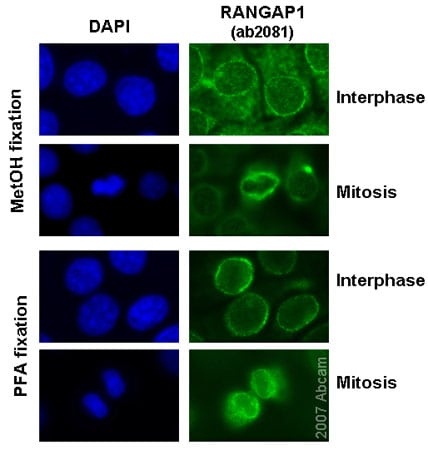Anti-RanGAP1 antibody (ab2081)
Key features and details
- Goat polyclonal to RanGAP1
- Suitable for: WB, ICC/IF
- Reacts with: Mouse, Human
- Isotype: IgG
Overview
-
Product name
Anti-RanGAP1 antibody
See all RanGAP1 primary antibodies -
Description
Goat polyclonal to RanGAP1 -
Host species
Goat -
Specificity
There is a hypothetical protein called "similar to RANGAP1" (XP_139737.2) that is virtually identical. -
Tested Applications & Species
See all applications and species dataApplication Species ICC/IF HumanWB Mouse -
Immunogen
Synthetic peptide: ASEDIAKLAETLAK, corresponding to N terminal amino acids 2-15 of Human RanGAP1.
-
Positive control
- 3T3 lysate.
-
General notes
Ran is a small signaling GTPase that is involved in nucleocytoplasmic transport. Two additional functions of animal Ran in the formation of spindle asters and the reassembly of the nuclear envelope in mitotic cells have been recently reported. In contrast to Ras or Rho, Ran is not associated with membranes. Instead, the spatial sequestering of its accessory proteins, the Ran GTPase-activating protein RanGAP 1 and the nucleotide exchange factor RCC1, appears to define the local concentration of RanGTP vs. RanGDP involved in signaling. Mammalian RanGAP 1 is bound to the nuclear pore by a mechanism involving the attachment of small ubiquitin-related modifier protein (SUMO) to its C terminus and the subsequent binding of the SUMOylated domain to the nucleoporin Nup358.
Properties
-
Form
Liquid -
Storage instructions
Shipped at 4°C. Upon delivery aliquot and store at -20°C or -80°C. Avoid repeated freeze / thaw cycles. -
Storage buffer
pH: 7.30
Preservative: 0.02% Sodium azide
Constituents: Tris buffered saline, 0.5% BSA -
 Concentration information loading...
Concentration information loading... -
Purity
Immunogen affinity purified -
Purification notes
Purified from goat serum by ammonium sulphate precipitation followed by antigen affinity chromatography using the immunizing peptide. -
Primary antibody notes
Ran is a small signaling GTPase that is involved in nucleocytoplasmic transport. Two additional functions of animal Ran in the formation of spindle asters and the reassembly of the nuclear envelope in mitotic cells have been recently reported. In contrast to Ras or Rho, Ran is not associated with membranes. Instead, the spatial sequestering of its accessory proteins, the Ran GTPase-activating protein RanGAP 1 and the nucleotide exchange factor RCC1, appears to define the local concentration of RanGTP vs. RanGDP involved in signaling. Mammalian RanGAP 1 is bound to the nuclear pore by a mechanism involving the attachment of small ubiquitin-related modifier protein (SUMO) to its C terminus and the subsequent binding of the SUMOylated domain to the nucleoporin Nup358. -
Clonality
Polyclonal -
Isotype
IgG -
Research areas
Images
-
ab2081 at a concentration of 0.2
µ g/ml staining approximately 70kda RanGAP1 in 3T3 whole cell lysate (RIPA buffer, 35µ g total protein per lane) by Western blot (ECL). Primary incubation = 1 hour. ab2081 at a concentration of 0.2µg/ml staining approximately 70kda RanGAP1 in 3T3 whole cell lysate (RIPA buffer, 35µg total protein per lane) by Western blot (ECL). Primary incubation = 1 hour. -
 Immunocytochemistry/ Immunofluorescence - Anti-RanGAP1 antibody (ab2081) Image courtesy of Marilena Ciciarello and Patrizia Lavia, University 'La Sapienza' CNR, Italyab2081 (1/500) detecting RanGap1 in mitotic and interphase Hela cells (green). Dapi was used as counterstain in order to highlight the nucleus (blue) and cells were fixed both in Methanol (-20 °C/ 6 mins, followed by 3 washes in PBS) or Paraformaldehyde (3,7% PFA /10 min at room temperature, 0,1% Triton/PBS 5 min, glycine 5 min, followed by 3 washes in PBS); This antibody also gave good results in NIH-3T3 cells under both the above mentioned fixation procedures (data not shown).
Immunocytochemistry/ Immunofluorescence - Anti-RanGAP1 antibody (ab2081) Image courtesy of Marilena Ciciarello and Patrizia Lavia, University 'La Sapienza' CNR, Italyab2081 (1/500) detecting RanGap1 in mitotic and interphase Hela cells (green). Dapi was used as counterstain in order to highlight the nucleus (blue) and cells were fixed both in Methanol (-20 °C/ 6 mins, followed by 3 washes in PBS) or Paraformaldehyde (3,7% PFA /10 min at room temperature, 0,1% Triton/PBS 5 min, glycine 5 min, followed by 3 washes in PBS); This antibody also gave good results in NIH-3T3 cells under both the above mentioned fixation procedures (data not shown).
















